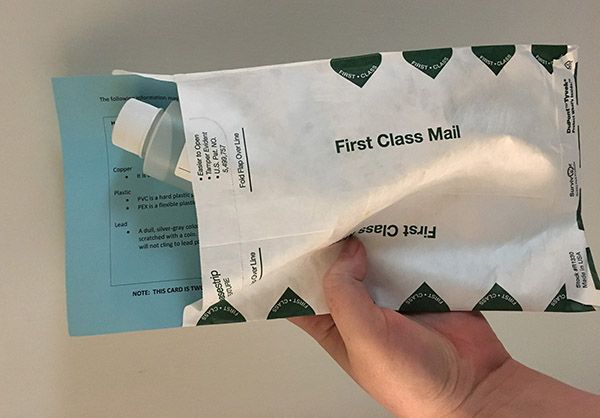Home Water Lead Testing – Consumer Protection Tips
Posted on January 20, 2022 by Charlotte Shuff
Tags, Water/Wastewater, General Interest

2022 Update: In light of recent reports about Portland’s problem with lead and water, CUB is re-releasing this guide. While these reports may seem scary, the issue does not affect all households. Homes with older plumbing (pre-1986) are most at risk for having elevated levels. Testing through the Portland Water Bureau is the most effective way (and free!) to know your risk and find prevention resources. Visit .(JavaScript must be enabled to view this email address) or call 503-988-4000 for your free water test.
Staying home more these days due to COVID-19? This could be the time to act on a consumer protection tip: test your water for lead.
A 2016 CUB blog details why and how lead was used in plumbing in the first place, including Oregon details and how all this relates to our drinking water. Steps have been taken over the years to mitigate risks from these older plumbing systems. Portland and other Oregon water utilities have increased water treatment protections. Additionally, many areas of the state, including Portland, never installed lead distribution pipes on the utility side of the water meter or lead service lines to homes. Now, lead primarily finds its way into drinking water from plumbing features inside of buildings.
Plumbing fixtures or solder that included lead were most commonly used until 1986, so newer homes are unlikely to have any opportunities for lead to leach into water. Some homes may have brass faucets with higher levels of lead than is now recommended. Any faucet made after 2014 is unlikely to have these high levels and homeowners can easily replace older brass faucets. Since it can be hard to identify individual areas of concern with plumbing hidden behind walls, though, it is easiest to test the water itself for contamination.
In the Portland area, you can request a free test kit from Multnomah County. In other areas of Oregon, contact your local water utility provider to see if they provide free testing. If that is not available, you can find an accredited lab to test your water.
For my Portland home, I received a free test kit from the Portland Water Bureau about two weeks after my original request. The test kit includes instructions, sample bottles, a postage-paid return envelope, and an information card that needs to be filled out by the customer and returned with the water sample.
To do the test, I planned to collect a water sample first thing in the morning before using my home water for anything else. Once I collected the water and filled out the information card, I put them in the pre-paid envelope and dropped it in the mail. The whole process took about five minutes, after taking the initial step of ordering the test and deciding what morning would work best for collecting a water sample.

I received a postcard from the Portland Water Bureau informing me of the results about two weeks after I mailed them my water sample. Although my home was built in 1970, there were no elevated levels of lead in the water and it is safe to drink. If you do find elevated levels of lead in your home water, the results will also include information about preventing exposure and additional resources.
Many prevention steps are easy to start while you are waiting for your results. The longer the water sits still, the more lead it might absorb from plumbing fixtures. Flushing out pipes after longer periods of not using your plumbing is a good precaution. To flush out your system, let the faucet run cold for two minutes. If you have recently flushed a toilet or taken a shower, 30 seconds is sufficient. Using cold water out of the tap also reduces the risk of lead being absorbed in water. Hot water absorbs lead about five times faster than cold water, so it is always best to pull water from the tap cold and heat it separately for cooking.
Using a filter at the faucet can also remove lead from drinking water. Before purchasing a filter, however, make sure that it is certified to remove lead particles. Many commonly used water filters are not rated to remove this particular contaminant. You can find a suitable filter for your home with the help of NSF, a lab certifier for sanitation.
For all this talk of water, readers may be surprised to know that paint is actually a more common source of lead contamination. For those in the Portland area, Community Energy Project offers free education and materials through their Lead Poisoning Prevention Workshop. The Oregon Health Authority also provides regular statewide updates on common lead hazards on their website, along with information to prevent exposure to lead at home.
To keep up with CUB, like us on Facbook and follow us on Twitter!





01/21/22 | 0 Comments | Home Water Lead Testing – Consumer Protection Tips